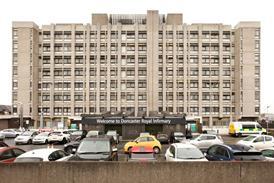Structural under-ventilation has long been a challenge throughout the NHS and targets for clean air delivery within healthcare are rightly ambitious, says Christian Hendriksen
The much publicised NHS backlog has now been exacerbated by Omicron. While staff absences and shortfalls are a significant contributor, other issues play a part in thwarting patient throughput. Like ventilation - or the lack of it.
Poor ventilation contributes to the backlog
Sponsored by
Structural under-ventilation has long been a challenge throughout the NHS, mainly due to inadequate existing ventilation systems in older hospitals and prohibitive retrofit costs and disruption.
When a highly infectious disease paralyses the nation’s health facilities, poor ventilation has a direct impact in terms of reduced operating capacity (to allow for social distancing) and increased fallow time between treatments (to remove virus particles, especially after Aerosol Generating Procedures).
Air change standards are a bottleneck
Targets for clean air delivery within healthcare are ambitious, and rightly so. The WHO’s latest ventilation roadmap stipulates 160 L/s/patient or 12 ACH where Aerosol Generating Procedures (AGPs) are performed, with a fallback position of 60 L/s/patient or 6 ACH in other areas such as wards.
The WHO’s advice to ‘consider reducing the maximum room occupancy to meet the L/s/patient standard’ puts severe capacity constraints on hospitals and perpetuates the backlog. Poor ventilation also extends fallow periods after AGPs, potentially doubling the time it takes to reach the stipulated 99.9% removal of airborne contaminants. Another underestimated impact is the spread of non-epidemic nosocomial infections, 10 to 24% of which are spread through the air, prolonging hospital stays and adding to waiting lists.
Bridging the ventilation gap
To bridge the ventilation gap, the WHO states that ‘If no other (short-term) strategy can be adopted, consider using a stand-alone air cleaner with HEPA filters.’ Portable air purifiers offer a universally practical infection control measure, such that ‘Total Ventilation = Outside Air Ventilation + Portable Air Purification’. By plugging the clean air gap, room occupancy can be increased, adding patient capacity while mitigating risk.
The SAGE committee’s November 2020 report on air cleaning to mitigate Covid transmission recommends portable air purifiers for reducing airborne transmission in poorly ventilated spaces. It endorses subtractive technologies (filtration and direct inactivation) - specifically fibrous filtration (HEPA) and germicidal UV (UVC) - which together trap and inactivate the virus, as safe and effective technologies.
Portable air purification is the practical solution
While poor ventilation is one root cause of the NHS backlog, it’s an easy fix.
Not only can clean air restore capacity, reduce fallow time and help clear the backlog. There is a sizable energy cost saving in using air purifiers instead of increasing the AHU ventilation rate or opening windows and cranking up the heating: enough to offset the capital cost of the units over a relatively short period.
While the healthcare sector has much to vent about that is beyond its control, achieving the correct level of indoor air quality is well within the gift of hospital management.
For more information click here. Hospital-grade air purification made portable.




























